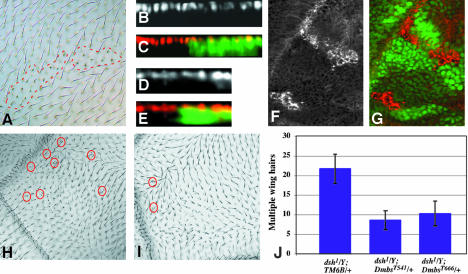Figure 3.
Mbs affects wing hair development but not the wing disc epithelium. (A) MbsT666 mutant clones in an adult wing. The clones are unmarked, but can be identified by the short and sometimes forked wing hairs (outlined with red dashed lines). (B-E) Cross sections of third instar wing discs containing MbsT666 mutant clones, with wild-type tissue labeled with GFP in green in C and E. Nuclei are stained with anti-Nubbin (B, red in C), and the apical surface is stained with anti-E-cadherin (D, red in E). No alterations in apical/basal localization are apparent within the clones. (F and G) Phospho-MRLC antibody staining of MbsT666 clones in the wing disc (F, red in G). Wild-type tissue is marked with GFP (green in G). p-Sqh is strongly up-regulated in the clones. (H) Multiple wing hair formation and altered polarity in a dsh1/Y mutant wing. (I) Suppression of multiple hairs, but not polarity, in dsh1/Y; MbsT541/+. Examples of duplicated wing hairs are circled in red. (J) Quantification of the suppression of dsh1 multiple wing hairs in Mbs heterozygotes. Wing hairs were counted in a region bordered by veins 3 and 5, the cross-veins and the wing margin.

